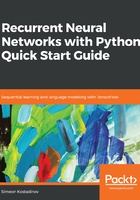
What this book covers
Chapter 1, Introducing Recurrent Neural Networks, will provide you with a brief introduction to the basics of RNNs and will compare the model to other popular models and demonstrate why RNNs are the best. This chapter will then illustrate RNNs with the use of an example. You will also be given insight into the problems that RNNs have.
Chapter 2, Building Your First RNN with TensorFlow, will explore how to build a simple RNN to solve the problem of identifying sequence parity. You will also gain a brief understanding of the TensorFlow library and how it can be utilized for building DL models. After reading this chapter, you should have a full understanding of how to use TensorFlow with Python and how easy and straightforward it is to build a neural network.
Chapter 3, Generating Your Own Book Chapter, will also introduce a new and more powerful RNN model called the gated recurrent unit (GRU). You will learn how it works and why we are choosing it over the simple RNN. You will also go step by step over the process of generating a book chapter. By the end of this chapter, you should have gained both a theoretical and a practical knowledge that will give you the freedom to experiment with any problems of medium difficulty.
Chapter 4, Creating a Spanish-to-English Translator, will walk you through building a fairly sophisticated neural network model using the sequence-to-sequence model implemented with the TensorFlow library. You will build a simple version of a Spanish-to-English translator, which will accept a sentence in Spanish and output its English equivalent.
Chapter 5, Building Your Personal Assistant, will then look on the practical side of RNNs and have you build a conversational chatbot. This chapter reveals a full implementation of a chatbot system that manages to construct a short conversation. You will then create an end-to-end model that aims to yield meaningful results. You will make use of a high-level TensorFlow-based library called TensorLayer.
Chapter 6, Improving Your RNN's Performance, will go through some techniques for improving your RNN. This chapter will focus on improving your RNN's performance with data and tuning. You will also look into optimizing the TensorFlow library for better results.